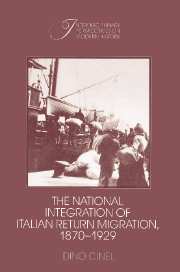Book contents
- Frontmatter
- Contents
- Acknowledgments
- Introduction: Emigration and the process of national integration
- 1 The difficult task of national integration
- 2 A blueprint for change
- 3 The southern ethos
- 4 The national debate
- 5 Return migration
- 6 American remittances
- 7 Investing American savings
- 8 Regional differences
- 9 Return and retirement
- Conclusion: National integration and return migration
- Notes
- Index
6 - American remittances
Published online by Cambridge University Press: 03 December 2009
- Frontmatter
- Contents
- Acknowledgments
- Introduction: Emigration and the process of national integration
- 1 The difficult task of national integration
- 2 A blueprint for change
- 3 The southern ethos
- 4 The national debate
- 5 Return migration
- 6 American remittances
- 7 Investing American savings
- 8 Regional differences
- 9 Return and retirement
- Conclusion: National integration and return migration
- Notes
- Index
Summary
As returnees pursued their private goals by crossing the Atlantic in both directions, their quest did not go unnoticed. And the savings they carried with them or channeled home before their final return stimulated debates and interests that were to last a long time. Italian villagers were mesmerized by remittances. In many small towns nobody had ever heard of so much money. Adolfo Rossi, an Italian commissioner of emigration, for instance, reported that in Sanfili, a a town of 5,000 people in the province of Cosenza, five brothers emigrated to the United States in the late 1890s and returned after eight years with 200,000 lire. With that money they bought a large property and two houses. Savings and returnees became the strongest argument in favor of leaving even for those who had rejected emigration initially. Social scientists interested in the economic development of Italy saw the tremendous potential of remittances. Individual savings were small, they remarked, but their aggregate was substantial. How could the national economy take advantage of this capital? Could remittances be channeled toward larger goals than the private ones pursued by returnees?
Politicians too took an interest in remittances. How could the state facilitate the flow of remittances into Italy, prevent immigrants from investing abroad, and use remittances as a way to accumulate hard currency? The arrival of increasingly strong American dollars was a particularly enticing occurrence, as Italy was joining the most developed Western nations in international markets.
- Type
- Chapter
- Information
- The National Integration of Italian Return Migration, 1870–1929 , pp. 122 - 149Publisher: Cambridge University PressPrint publication year: 1991



